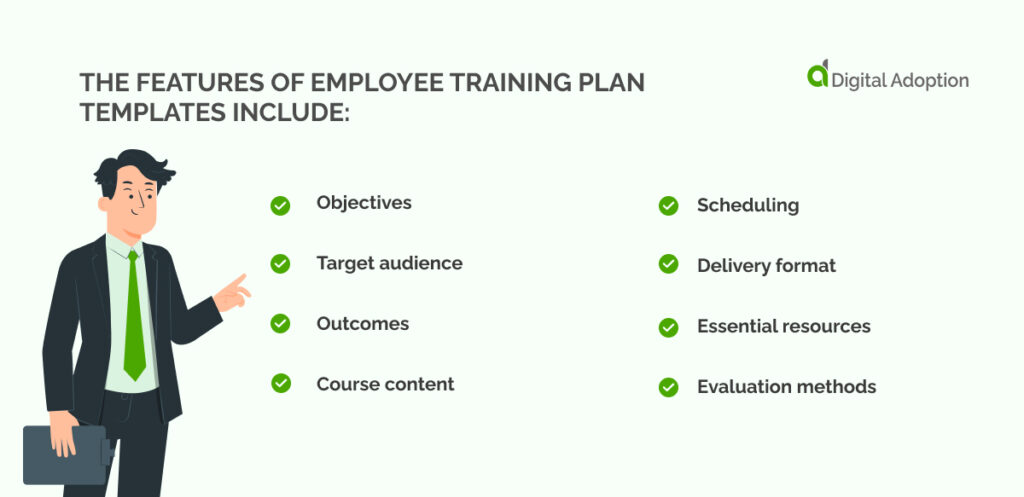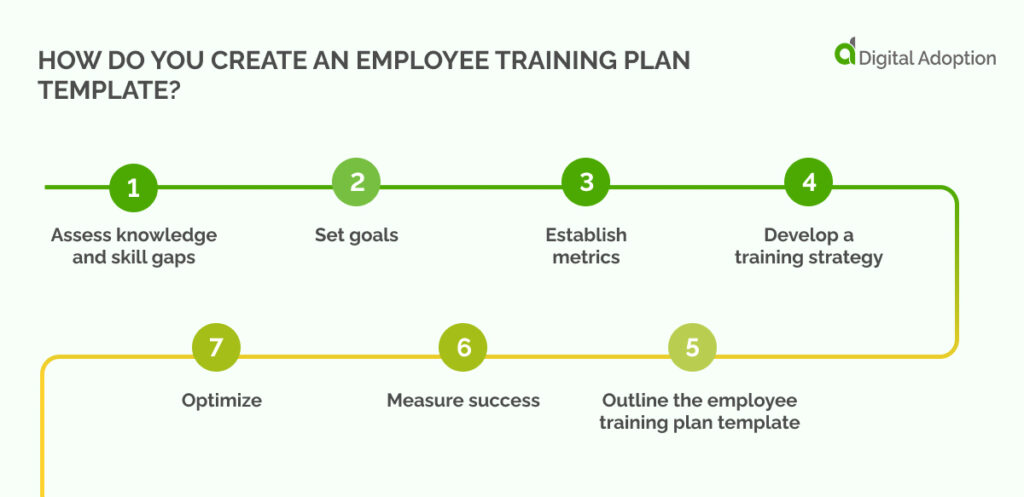It can be overwhelming for staff to organize their training amongst all their other enterprise responsibilities.
Employee training plan templates are the solution to organizing training within a structured framework. They show what and where training needs to happen, taking the stress out of organizing learning experiences for professional development.
Enterprise spending on training decreased from USD 19.2 billion to USD 16.1 billion from 2022 to 2023. With reduced training spending likely in 2024, optimizing ROI on training services and products with employee training plan templates that increase attendance, training quality, and digital employee experience through remote training is essential.
This article defines an employee training template, lists the 11 best and free templates, describes the features of training plan templates, and concludes with how to create a template.
After reading, you’ll have the knowledge and confidence to support staff with detailed, helpful training plan templates, promote attendance, and increase the training ROI for your skilled workforce.
What is an employee training plan template?
Employee training plan templates outline the necessary skills, objectives, and timelines for workforce development. They include a training schedule, materials, methods, evaluation criteria, and follow-up activities to ensure effective learning.
These templates streamline the training process, ensuring consistency and alignment with organizational goals while accommodating various learning styles and needs.
11 Best + free employee training plan templates
Employee training plan templates are vital to standardize training, ensuring all employees receive consistent and comprehensive instruction. They address gaps in skills and knowledge, enhancing productivity and performance. Enterprises benefit from improved efficiency, reduced training costs, and a more competent workforce.
Check out the staff training plan templates below and choose the best to support your staff to become skilled additions to your organization for constant innovation and higher revenue.
- New-hire training plan template
Training new employees on company policies, standard operating procedures (SOPs), and more is crucial. HR departments can develop a sample training template to ensure every new team member experiences the correct onboarding process, including product walkthroughs to help familiarise new staff with tools.
They can also help you consider how to increase employee onboarding through better new-hire training.
You can choose to make this training plan either employee-facing or private. If kept private, your HR team can use the template to take notes about new hires. If it’s employee-facing, you can include links to resources new hires need.
- Safety training template
Safety training is essential for ensuring employees adhere to all safety protocols, as inadequate training can lead to severe consequences. It’s crucial to address all necessary topics comprehensively.
One example is customizing your employee training plan template to establish protocols for safely handling chemicals.
You can also use this template to train employees on safety procedures such as fire drills, harassment policies, and other critical areas. This approach guarantees thorough preparation and promotes a safe, compliant workplace environment.
You reduce risks and enhance workplace safety by systematically covering these aspects.
- Executive training template
To develop your workforce and nurture potential talent, it’s crucial to help employees acquire skills necessary for executive roles, which differ significantly from other positions. Key training areas for executives include public speaking, leadership, and risk management.
An executive training plan template can incorporate training in any of these areas, tailored to the executive’s specific role. One example is if an individual frequently leads meetings, they would benefit from public speaking training.
This approach ensures that emerging leaders are well-prepared for the unique challenges of executive responsibilities.
- Diversity training template
Diversity training plan templates are essential for promoting an inclusive workplace where all employees feel valued and respected.
They guide enterprises in delivering consistent and comprehensive diversity training, covering crucial topics like unconscious bias, cultural competence, and inclusive communication.
By using these templates, companies can ensure all staff receive the same level of education on diversity issues, promoting understanding and collaboration. Benefits include improved employee morale, increased innovation from diverse perspectives, and a positive, inclusive company reputation.
For staff, these templates enhance interpersonal skills and create a more supportive and equitable work environment, leading to higher job satisfaction and retention.
- Training needs assessment template
A training needs assessment template allows you to plan tailored development for each employee. It’s beneficial for identifying competency gaps and creating personalized learning paths.
This template helps determine which skills and knowledge areas require enhancement, what resources the organization should offer, and the employee’s preferred learning method.
This tool ensures that training is relevant and practical, addressing specific needs and promoting continuous professional growth. This targeted approach leads to better skill alignment, increased productivity, and a more competent and motivated workforce.
- Individual employee training plan template
An individual employee training plan template is crucial for personalizing development initiatives. It addresses each employee’s unique needs, skills, and career aspirations and helps align employee growth with the company’s objectives.
The template typically includes sections for setting specific goals, identifying skill gaps, scheduling training sessions, and tracking progress. It may also feature assessment tools and feedback mechanisms.
Personalized training plans enhance employee engagement and motivation, improve performance, and increase retention rates. They also help close skill gaps efficiently, leading to a more competent and satisfied workforce.
- Employee development plan template
An employee development plan template focuses on long-term growth and career advancement. It is essential for nurturing talent, preparing employees for future roles, and promoting a culture of continuous improvement.
This template outlines development goals, required skills, action steps, timelines, and resources. It often includes mentorship and coaching components and periodic review sections to assess progress.
Employee development plans enhance workforce skills, boost morale, and support succession planning. They help employees see a clear career path within the company, increasing loyalty and reducing turnover.
- Technical training template
Technical training templates ensure employees have the technical skills to perform their jobs effectively. This point is critical in industries with rapid technological advancements.
The template includes modules for technical skills, assessment criteria, training schedules, and resources like software and manuals. It often features hands-on practice sessions and troubleshooting guides.
Practical technical training improves job performance, reduces errors, and enhances innovation. It ensures employees are up-to-date with the latest technologies and methodologies, maintaining the company’s competitive edge.
- Remote work policy template
A remote work policy template is vital for establishing clear guidelines and expectations for remote work, which has become increasingly prevalent. It ensures consistency and fairness in managing remote employees.
This template includes sections on eligibility, communication protocols, data security, performance metrics, and equipment usage. It outlines the responsibilities of both employees and employers.
Clear remote work policies improve productivity, enhance work-life balance, and ensure security and compliance. They also help manage remote teams effectively, reduce misunderstandings, and increase employee satisfaction.
- 70-20-10 Learning model template
The 70-20-10 learning model template is essential for structuring a balanced approach to employee development, combining formal training, social learning, and experiential learning.
This template allocates 70% of learning to on-the-job experiences, 20% to interactions with others (e.g., mentoring), and 10% to formal education. It includes guidelines for each learning type and integration strategies.
The model promotes comprehensive skill development, enhances knowledge retention, and encourages continuous learning. It leverages real-world experiences and social interactions, making learning more practical and relevant.
- SMART goals template
A SMART goals template is important for setting clear, achievable, and measurable objectives. It ensures that goals are Specific, Measurable, Achievable, Relevant, and Time-bound, driving better performance and outcomes.
The template guides employees in defining each component of SMART goals, tracking progress, and evaluating results. It includes sections for goal description, success criteria, deadlines, and review checkpoints.
Using SMART goals improves focus, accountability, and motivation. It helps set realistic expectations, measure progress accurately, and achieve objectives efficiently, ultimately contributing to personal and organizational success.
Use these examples of employee training plan templates to structure training and support employees’ awareness of upcoming training. This approach will increase attendance and achieve ROI on training products and services.
What are the features of employee training plan templates?

It’s essential to consider the features of each training plan template for every employee.
This structured approach optimizes training by offering employees a clear path to tracking their development, expanding their expertise, and driving organizational success.
The features of employee training plan templates include:
Objectives
The training plan’s primary learning goals focus on what participants are expected to achieve and master by the end of the program.
Target audience
Details of who will use the training, including job roles, experience levels, and any specific qualifications or prerequisites required.
Outcomes
The specific skills and knowledge learners should acquire during the training ensure alignment with individual and organizational goals.
Course content
An outline of the topics and subjects covered throughout the training program, ensuring comprehensive coverage of all relevant material.
Scheduling
A detailed timeline that outlines all milestones and key dates, ensuring participants and trainers can manage their time effectively.
Delivery format
The approach to delivering training is through classroom lectures, online courses, webinars, or a blend of these methods.
Essential resources
A list of all materials, tools, and technology needed to successfully conduct the training, ensuring all participants are adequately prepared.
Evaluation methods
The methods and processes used to assess the training program’s effectiveness, including feedback mechanisms and performance metrics.
How do you create an employee training plan template?

Sometimes, pre-made templates are fine, but most enterprises will need custom templates at some point. Follow these steps to create your templates for employee training plans and enjoy the benefits of alignment with organizational goals, enhanced consistency, and optimized resource utilization for effective skill development.
Assess knowledge and skill gaps
Skills gaps in your organization are more likely due to technological advancements and market fluctuations than employee competence. When assessing these gaps, consider both short-term and long-term business goals.
For example, if your goal is to integrate artificial intelligence (AI) more deeply into your operations, your team members may be unsure how to leverage these tools to enhance efficiency.
To identify your current upskilling and learning opportunities, use an employee survey. Conduct a brief, two-question pulse survey to ask staff what skills they need to perform their roles better, providing valuable insights.
Next, re-examine your career progression framework. If your company structure has evolved, new skills or competencies may be required for employees to thrive in their current roles.
Finally, use your network or connect with peers to understand the skills and knowledge gaps they are facing and prioritize. You can also use this step to consider which tools you may want to use to implement the training. Consider the advantages and limitations of LMS vs DAP when choosing learning technology.
Set goals
Once you understand the skills employees need to develop or enhance, you can define specific objectives for each training plan. While these objectives should align with your company vision, they should also be more attainable and precise than broader, long-term business goals.
Here are some common training objectives:
- Enhancing technical skills or competency with software.
- Developing intercultural competencies for diversity, equity, and inclusion.
- Expanding industry and regulatory knowledge.
- Improving customer service skills.
- Sharpening decision-making skills.
- Becoming more confident with conflict resolution techniques.
- Managing time more effectively.
Set these goals to structure your approach to template creation, ensure success, and facilitate measurement via metrics.
Establish metrics
Evaluating the success of your training plan is essential for identifying potential improvements and increasing the return on investment. It also helps determine if the training meets your objectives and contributes to broader company goals.
Effective training should positively impact performance, productivity, engagement, and retention.
To measure effectiveness, use multiple approaches, such as:
- Completion rates: Quickly assess if the training is too complicated or lengthy and investigate any factors hindering progress.
- Survey scores: Collect post-training employee feedback through anonymous surveys to evaluate if the training enhances skills, enables better performance in current roles, or facilitates career advancement.
- Percentage of goals reached: Monitor how many team members achieve their training goals to understand their progress.
- Qualitative feedback: Arrange 1:1 meetings between leaders and training participants to discuss progress and identify areas for improvement.
Use these approaches to measure success effectively.
Develop a training strategy
Creating a training strategy involves identifying organizational goals, assessing skill gaps, and determining training methods.
It includes defining objectives, such as enhancing technical skills or fostering leadership qualities, and aligning them with the company vision.
The strategy should consider resources, budget, and timeline constraints while ensuring relevance to employee development needs and business objectives.
Outline the employee training plan template
Outline the employee training plan template by detailing objectives, target audience, desired outcomes, course content, schedules, delivery methods, and required resources.
This template should include:
- Specific steps in the training journey: A single step, or action item, would be, for instance, “Have the employee conduct a product tour for Salesforce.”
- Stages that include training: These are longer-term phases encompassing several action items. The onboarding stage, for example, would focus on early-stage training, such as software onboarding steps and product tours.
- Goals for each step: Goals should include tasks and, when necessary, performance metrics. For example, if an employee is required to take a test, a minimum grade should mark the task as complete.
This structured approach ensures clarity and consistency in training implementation across the organization.
The template serves as a roadmap, guiding trainers and participants through the learning journey while facilitating effective communication and evaluation of training effectiveness.
Measure success
Remember those metrics you established in step 3? Now, it’s time to use them.
Measuring training success involves using key performance indicators (KPIs) such as completion rates, skill improvement assessments, and feedback surveys using training survey questions. Quantitative data helps gauge the impact of training on employee performance and organizational goals.
Qualitative feedback provides insights into participant satisfaction and areas for improvement. Regular evaluation ensures that training objectives are met and identifies opportunities for refinement to enhance overall training effectiveness and return on investment (ROI).
Optimize
You’re nearly at the finish line, but not quite.
You have a great template or a set of several, but now you need to improve and update them constantly.
Optimizing the training plan involves analyzing evaluation results to identify strengths and weaknesses. Adjustments may include updating content, refining delivery methods, or reallocating resources to better meet training goals.
Continuous improvement ensures that training remains relevant and impactful amid evolving business needs and technological advancements.
Collaboration between trainers, HR, and leadership promotes a culture of learning and development, supporting ongoing skill enhancement and organizational growth.
Deliver consistency with employee training plan templates
Using employee training plan templates isn’t just a box-ticking exercise for training attendance. When you build and implement them properly, they can also ensure a standardized approach to skill development across your organization.
The first way to achieve this is by using standardized procedures. Ensure uniform training practices and content across departments. Next, use clear, easy-to-follow objectives: Align training with company goals.
Finally, content should be relevant with regular training plan template updates. Use employee satisfaction survey questions to assess employee satisfaction with implementing new templates to support training.
Consistency in training leads to more equitable skill development, improves overall performance, and helps maintain quality standards. Utilizing templates streamlines the training process, making it more efficient and effective for trainers and trainees.
This approach ensures training ROI and higher revenue as staff productivity and innovation improve.
People Also Ask
-
How can training plan templates improve ROI when training budgets are constrained?With enterprise spending on training dropping from $19.2 billion to $16.1 billion (2022–2023), optimized templates that boost attendance, digital delivery, and training effectiveness help maximize impact per investment.
-
Why should organizations tailor templates by training type (e.g., onboarding vs cross‑training)?Different training needs—such as onboarding, annual refreshers, cross-training, and compliance—require distinct structures and content. Customizing templates ensures relevance, efficiency, and alignment with learning goals.
-
When is it best to use a strategic training plan template versus a schedule template?Use a strategic training plan template to define goals, audience, methods, and measurements. Once those are set, implement with a schedule template for logistics like timing, delivery format, and facilitators.
-
What if an organization needs to quickly adapt training—how do templates help?Templates standardize structure while allowing flexibility. This saves planning time and lets leaders focus on tailoring content and delivery mechanisms for rapid adaptation.









